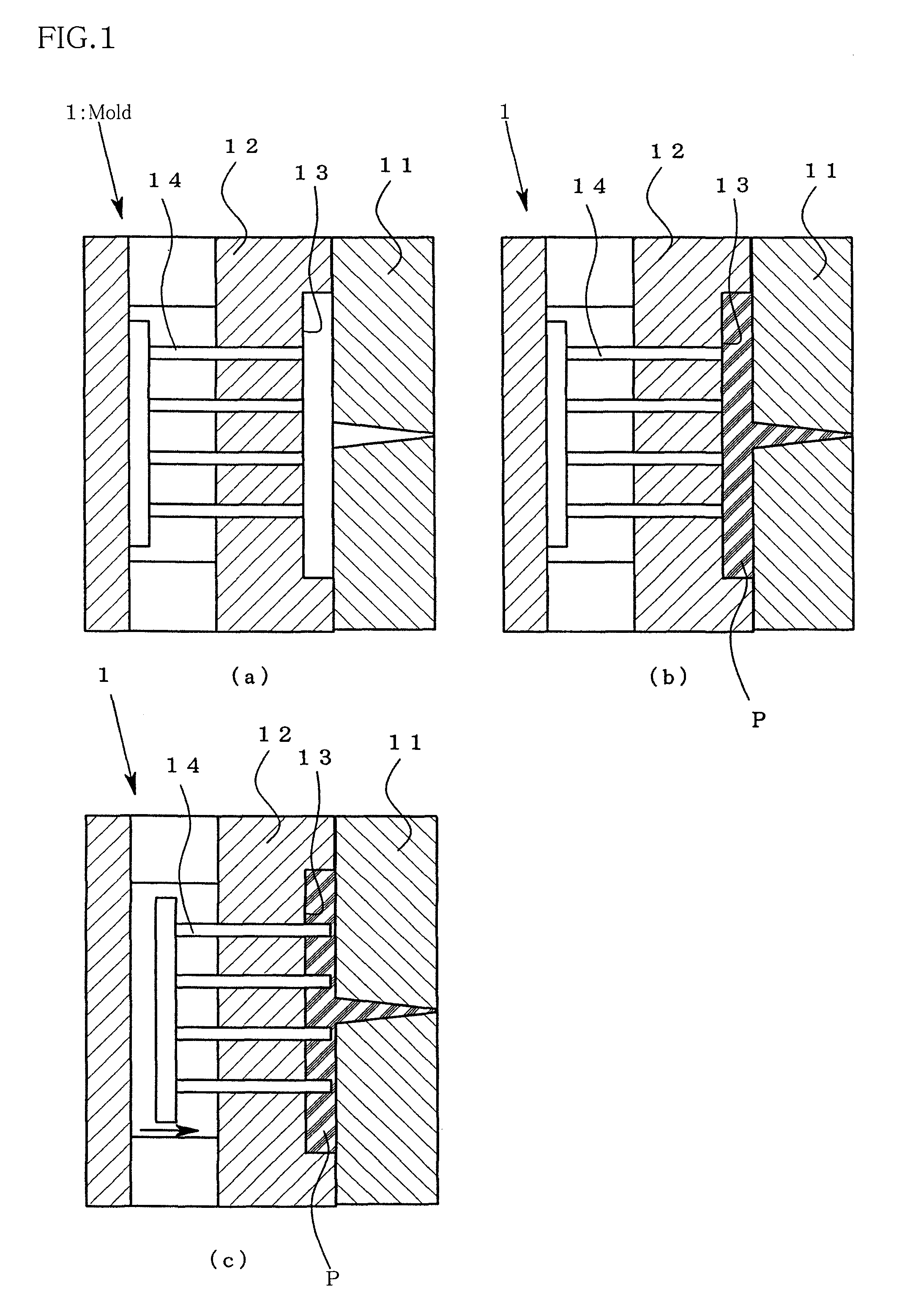Process for producing sound absorber and produced by the process, sound absorber and sound absorbing structure
a technology of sound absorber and process, which is applied in the direction of instruments, heat measurement, buttons, etc., can solve the problems that the above-mentioned conventional sound absorber or sound insulator cannot exhibit both sound absorbing properties and sound insulating properties, and the absorption of rigid materials is not expected to be rigid and not expected to exhibit sound insulating properties, etc., to achieve selective absorption of targeted specifics, improve productivity, and improve the effect of productivity
- Summary
- Abstract
- Description
- Claims
- Application Information
AI Technical Summary
Benefits of technology
Problems solved by technology
Method used
Image
Examples
first embodiment of
Production Process
[0074]As shown in FIG. 1(a), the movable part 12 is moved toward the fixed part 1 to perform clamping.
[0075]After clamping, the resin material P is injected into the cavity 13, as shown in FIG. 1(b).
[0076]Subsequently, as shown in FIG. 1(c), the pin 14 is advanced immediately after injection to cause the pin 14 to project into the cavity 13.
[0077]The length of the projected part of the pin 14 may be a length which is enough to penetrate one of the skin layers and is not enough to reach the other skin layer. Preferably, the length of the projected part of the pin 14 is adjusted in advance such that the length becomes 30 to 90% of the thickness of a final molded article (sound absorber). Alternatively, changing the length of the projected part of the pin 14 may preferably be synchronized with retraction of the movable part 12.
[0078]Subsequently, as shown in FIG. 2(a), the resin material P is caused to expand while opening the mold slightly. Preferably, the resin mate...
second embodiment of
Production Process
[0083]The procedures for molding a sound absorber in this embodiment are basically the same as the procedures for molding in the first embodiment as shown in FIGS. 1(a) to 1(c) and in FIGS. 2(a) and (b). In this embodiment, timing of retraction of the pin 14 shown in FIG. 2(b) is different from that in the first embodiment.
[0084]Specifically in this embodiment, the pin 14 is caused to retract when at least part of the inner peripheral surface of the hole of the resin material P which is in contact with the outer peripheral surface of the pin 14 is solidified to cause the skin layer to be formed.
[0085]FIG. 4 is a schematic view showing the manner in which a sound absorber is formed in the second embodiment. FIG. 4(a) is an enlarged cross-sectional view of the hole of the resin material before expansion. FIG. 4(b) is an enlarged cross-sectional view of the hole part of the resin material immediately after the start of expansion. FIG. 4(c) is a cross-sectional view of...
third embodiment of
Production Process
[0089]The production process according to the third embodiment of the invention will be described below with reference to FIG. 5.
[0090]In this embodiment, after the resin material is injected into the cavity 13 after clamping as shown in FIG. 5(a), the movable part 12 is caused to retract to allow the resin material P to expand as shown in FIG. 5(b).
[0091]As shown in FIG. 5(c), before the resin material P in the cavity 13 is solidified, the pin 14 is advanced and caused to project into the cavity 13.
[0092]In this case, it is preferred that the projected part of the pin is long enough to penetrate one of the skin layers and is not long enough to reach the other skin layer. Preferably, the length of the projected part of the pin is 30 to 90% of the thickness of the final molded article (sound absorber).
[0093]The pin 14 is caused to retract with a prescribed timing as shown in FIG. 5(d).
[0094]The pin 14 is caused to retract, as explained in the first embodiment, befor...
PUM
| Property | Measurement | Unit |
|---|---|---|
| length | aaaaa | aaaaa |
| length | aaaaa | aaaaa |
| length | aaaaa | aaaaa |
Abstract
Description
Claims
Application Information
 Login to View More
Login to View More - R&D
- Intellectual Property
- Life Sciences
- Materials
- Tech Scout
- Unparalleled Data Quality
- Higher Quality Content
- 60% Fewer Hallucinations
Browse by: Latest US Patents, China's latest patents, Technical Efficacy Thesaurus, Application Domain, Technology Topic, Popular Technical Reports.
© 2025 PatSnap. All rights reserved.Legal|Privacy policy|Modern Slavery Act Transparency Statement|Sitemap|About US| Contact US: help@patsnap.com



